Zoltan Nagy
The University of Texas at Austin, USA
CityLearn v2: Energy-flexible, resilient, occupant-centric, and carbon-aware management of grid-interactive communities
May 02, 2024Abstract:As more distributed energy resources become part of the demand-side infrastructure, it is important to quantify the energy flexibility they provide on a community scale, particularly to understand the impact of geographic, climatic, and occupant behavioral differences on their effectiveness, as well as identify the best control strategies to accelerate their real-world adoption. CityLearn provides an environment for benchmarking simple and advanced distributed energy resource control algorithms including rule-based, model-predictive, and reinforcement learning control. CityLearn v2 presented here extends CityLearn v1 by providing a simulation environment that leverages the End-Use Load Profiles for the U.S. Building Stock dataset to create virtual grid-interactive communities for resilient, multi-agent distributed energy resources and objective control with dynamic occupant feedback. This work details the v2 environment design and provides application examples that utilize reinforcement learning to manage battery energy storage system charging/discharging cycles, vehicle-to-grid control, and thermal comfort during heat pump power modulation.
CityTFT: Temporal Fusion Transformer for Urban Building Energy Modeling
Dec 04, 2023Abstract:Urban Building Energy Modeling (UBEM) is an emerging method to investigate urban design and energy systems against the increasing energy demand at urban and neighborhood levels. However, current UBEM methods are mostly physic-based and time-consuming in multiple climate change scenarios. This work proposes CityTFT, a data-driven UBEM framework, to accurately model the energy demands in urban environments. With the empowerment of the underlying TFT framework and an augmented loss function, CityTFT could predict heating and cooling triggers in unseen climate dynamics with an F1 score of 99.98 \% while RMSE of loads of 13.57 kWh.
Filling time-series gaps using image techniques: Multidimensional context autoencoder approach for building energy data imputation
Jul 13, 2023Abstract:Building energy prediction and management has become increasingly important in recent decades, driven by the growth of Internet of Things (IoT) devices and the availability of more energy data. However, energy data is often collected from multiple sources and can be incomplete or inconsistent, which can hinder accurate predictions and management of energy systems and limit the usefulness of the data for decision-making and research. To address this issue, past studies have focused on imputing missing gaps in energy data, including random and continuous gaps. One of the main challenges in this area is the lack of validation on a benchmark dataset with various building and meter types, making it difficult to accurately evaluate the performance of different imputation methods. Another challenge is the lack of application of state-of-the-art imputation methods for missing gaps in energy data. Contemporary image-inpainting methods, such as Partial Convolution (PConv), have been widely used in the computer vision domain and have demonstrated their effectiveness in dealing with complex missing patterns. To study whether energy data imputation can benefit from the image-based deep learning method, this study compared PConv, Convolutional neural networks (CNNs), and weekly persistence method using one of the biggest publicly available whole building energy datasets, consisting of 1479 power meters worldwide, as the benchmark. The results show that, compared to the CNN with the raw time series (1D-CNN) and the weekly persistence method, neural network models with reshaped energy data with two dimensions reduced the Mean Squared Error (MSE) by 10% to 30%. The advanced deep learning method, Partial convolution (PConv), has further reduced the MSE by 20-30% than 2D-CNN and stands out among all models.
Physics-Informed Machine Learning for Modeling and Control of Dynamical Systems
Jun 24, 2023Abstract:Physics-informed machine learning (PIML) is a set of methods and tools that systematically integrate machine learning (ML) algorithms with physical constraints and abstract mathematical models developed in scientific and engineering domains. As opposed to purely data-driven methods, PIML models can be trained from additional information obtained by enforcing physical laws such as energy and mass conservation. More broadly, PIML models can include abstract properties and conditions such as stability, convexity, or invariance. The basic premise of PIML is that the integration of ML and physics can yield more effective, physically consistent, and data-efficient models. This paper aims to provide a tutorial-like overview of the recent advances in PIML for dynamical system modeling and control. Specifically, the paper covers an overview of the theory, fundamental concepts and methods, tools, and applications on topics of: 1) physics-informed learning for system identification; 2) physics-informed learning for control; 3) analysis and verification of PIML models; and 4) physics-informed digital twins. The paper is concluded with a perspective on open challenges and future research opportunities.
MERLIN: Multi-agent offline and transfer learning for occupant-centric energy flexible operation of grid-interactive communities using smart meter data and CityLearn
Dec 31, 2022



Abstract:The decarbonization of buildings presents new challenges for the reliability of the electrical grid as a result of the intermittency of renewable energy sources and increase in grid load brought about by end-use electrification. To restore reliability, grid-interactive efficient buildings can provide flexibility services to the grid through demand response. Residential demand response programs are hindered by the need for manual intervention by customers. To maximize the energy flexibility potential of residential buildings, an advanced control architecture is needed. Reinforcement learning is well-suited for the control of flexible resources as it is able to adapt to unique building characteristics compared to expert systems. Yet, factors hindering the adoption of RL in real-world applications include its large data requirements for training, control security and generalizability. Here we address these challenges by proposing the MERLIN framework and using a digital twin of a real-world 17-building grid-interactive residential community in CityLearn. We show that 1) independent RL-controllers for batteries improve building and district level KPIs compared to a reference RBC by tailoring their policies to individual buildings, 2) despite unique occupant behaviours, transferring the RL policy of any one of the buildings to other buildings provides comparable performance while reducing the cost of training, 3) training RL-controllers on limited temporal data that does not capture full seasonality in occupant behaviour has little effect on performance. Although, the zero-net-energy (ZNE) condition of the buildings could be maintained or worsened as a result of controlled batteries, KPIs that are typically improved by ZNE condition (electricity price and carbon emissions) are further improved when the batteries are managed by an advanced controller.
Real-world challenges for reinforcement learning in building control
Nov 25, 2021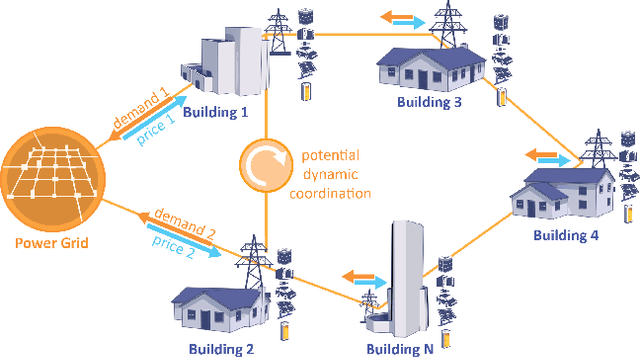



Abstract:Building upon prior research that highlighted the need for standardizing environments for building control research, and inspired by recently introduced benchmarks for real life reinforcement learning control, here we propose a non-exhaustive nine real world challenges for reinforcement learning building controller. We argue that building control research should be expressed in this framework in addition to providing a standardized environment for repeatability. Advanced controllers such as model predictive control and reinforcement learning control have both advantages and disadvantages that prevent them from being implemented in real world buildings. Comparisons between the two are seldom, and often biased. By focusing on the benchmark problems and challenges, we can investigate the performance of the controllers under a variety of situations and generate a fair comparison. Lastly, we call for a more interdisciplinary effort of the research community to address the real world challenges, and unlock the potentials of advanced building controllers.
MARTINI: Smart Meter Driven Estimation of HVAC Schedules and Energy Savings Based on WiFi Sensing and Clustering
Oct 17, 2021


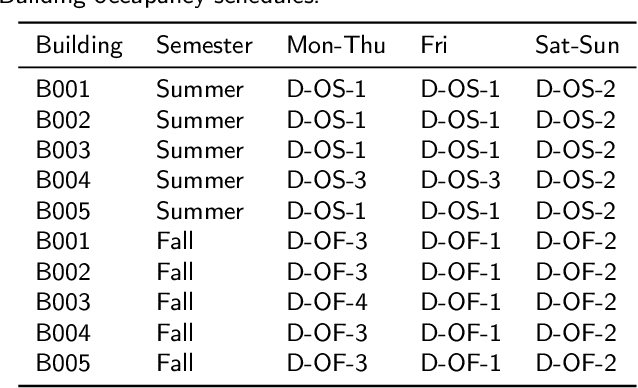
Abstract:HVAC systems account for a significant portion of building energy use. Nighttime setback scheduling is an energy conservation measure where cooling and heating setpoints are increased and decreased respectively during unoccupied periods with the goal of obtaining energy savings. However, knowledge of a building's real occupancy is required to maximize the success of this measure. In addition, there is the need for a scalable way to estimate energy savings potential from energy conservation measures that is not limited by building specific parameters and experimental or simulation modeling investments. Here, we propose MARTINI, a sMARt meTer drIveN estImation of occupant-derived HVAC schedules and energy savings that leverages the ubiquity of energy smart meters and WiFi infrastructure in commercial buildings. We estimate the schedules by clustering WiFi-derived occupancy profiles and, energy savings by shifting ramp-up and setback times observed in typical/measured load profiles obtained by clustering smart meter energy profiles. Our case-study results with five buildings over seven months show an average of 8.1%-10.8% (summer) and 0.2%-5.9% (fall) chilled water energy savings when HVAC system operation is aligned with occupancy. We validate our method with results from building energy performance simulation (BEPS) and find that estimated average savings of MARTINI are within 0.9%-2.4% of the BEPS predictions. In the absence of occupancy information, we can still estimate potential savings from increasing ramp-up time and decreasing setback start time. In 51 academic buildings, we find savings potentials between 1%-5%.
GridLearn: Multiagent Reinforcement Learning for Grid-Aware Building Energy Management
Oct 12, 2021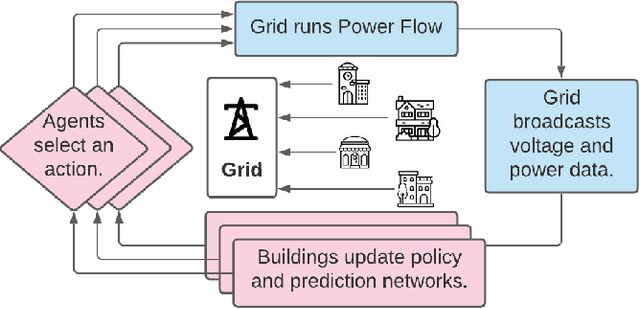

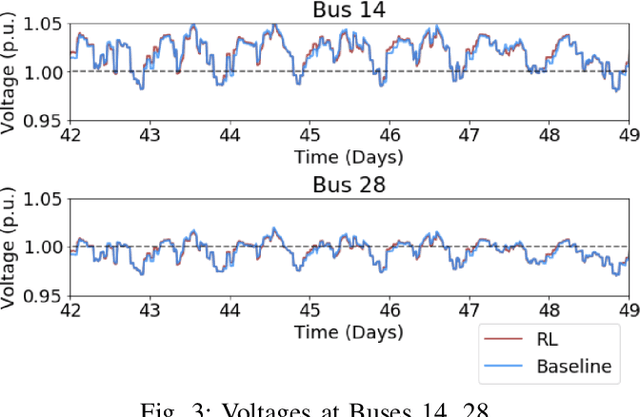
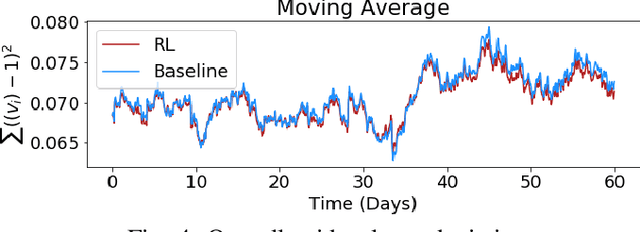
Abstract:Increasing amounts of distributed generation in distribution networks can provide both challenges and opportunities for voltage regulation across the network. Intelligent control of smart inverters and other smart building energy management systems can be leveraged to alleviate these issues. GridLearn is a multiagent reinforcement learning platform that incorporates both building energy models and power flow models to achieve grid level goals, by controlling behind-the-meter resources. This study demonstrates how multi-agent reinforcement learning can preserve building owner privacy and comfort while pursuing grid-level objectives. Building upon the CityLearn framework which considers RL for building-level goals, this work expands the framework to a network setting where grid-level goals are additionally considered. As a case study, we consider voltage regulation on the IEEE-33 bus network using controllable building loads, energy storage, and smart inverters. The results show that the RL agents nominally reduce instances of undervoltages and reduce instances of overvoltages by 34%.
CityLearn: Standardizing Research in Multi-Agent Reinforcement Learning for Demand Response and Urban Energy Management
Dec 18, 2020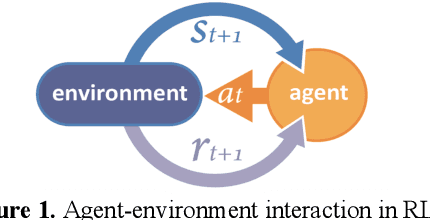
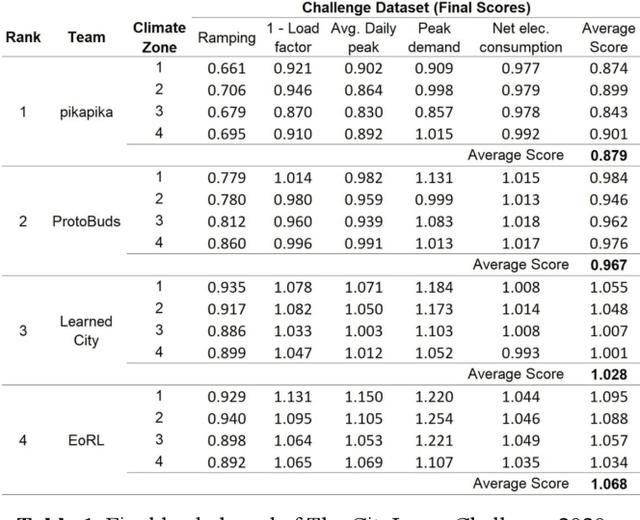
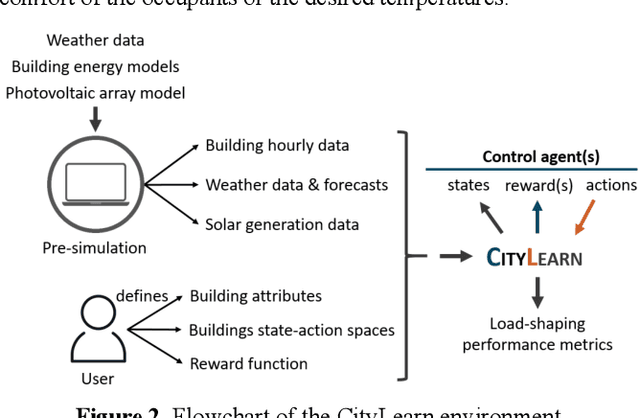
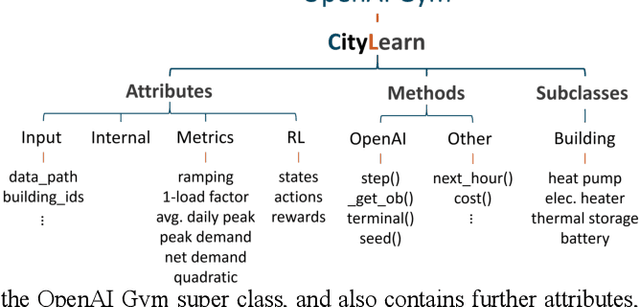
Abstract:Rapid urbanization, increasing integration of distributed renewable energy resources, energy storage, and electric vehicles introduce new challenges for the power grid. In the US, buildings represent about 70% of the total electricity demand and demand response has the potential for reducing peaks of electricity by about 20%. Unlocking this potential requires control systems that operate on distributed systems, ideally data-driven and model-free. For this, reinforcement learning (RL) algorithms have gained increased interest in the past years. However, research in RL for demand response has been lacking the level of standardization that propelled the enormous progress in RL research in the computer science community. To remedy this, we created CityLearn, an OpenAI Gym Environment which allows researchers to implement, share, replicate, and compare their implementations of RL for demand response. Here, we discuss this environment and The CityLearn Challenge, a RL competition we organized to propel further progress in this field.
Neural Network-Based Equations for Predicting PGA and PGV in Texas, Oklahoma, and Kansas
Jun 04, 2018



Abstract:Parts of Texas, Oklahoma, and Kansas have experienced increased rates of seismicity in recent years, providing new datasets of earthquake recordings to develop ground motion prediction models for this particular region of the Central and Eastern North America (CENA). This paper outlines a framework for using Artificial Neural Networks (ANNs) to develop attenuation models from the ground motion recordings in this region. While attenuation models exist for the CENA, concerns over the increased rate of seismicity in this region necessitate investigation of ground motions prediction models particular to these states. To do so, an ANN-based framework is proposed to predict peak ground acceleration (PGA) and peak ground velocity (PGV) given magnitude, earthquake source-to-site distance, and shear wave velocity. In this framework, approximately 4,500 ground motions with magnitude greater than 3.0 recorded in these three states (Texas, Oklahoma, and Kansas) since 2005 are considered. Results from this study suggest that existing ground motion prediction models developed for CENA do not accurately predict the ground motion intensity measures for earthquakes in this region, especially for those with low source-to-site distances or on very soft soil conditions. The proposed ANN models provide much more accurate prediction of the ground motion intensity measures at all distances and magnitudes. The proposed ANN models are also converted to relatively simple mathematical equations so that engineers can easily use them to predict the ground motion intensity measures for future events. Finally, through a sensitivity analysis, the contributions of the predictive parameters to the prediction of the considered intensity measures are investigated.
 Add to Chrome
Add to Chrome Add to Firefox
Add to Firefox Add to Edge
Add to Edge